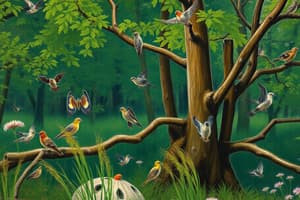Podcast
Questions and Answers
What does biodiversity refer to?
What does biodiversity refer to?
- The number of species that have been scientifically described
- The variety of species, genetic information, and ecosystems on Earth (correct)
- The total number of insects on Earth
- The genetic makeup of individual species
How many species are estimated to be invertebrates?
How many species are estimated to be invertebrates?
- 1.7 million
- 1.3 million (correct)
- 500,000
- 1.2 million
What is the estimated number of undiscovered species on Earth?
What is the estimated number of undiscovered species on Earth?
- 1.2 million
- 500,000 (correct)
- 1.7 million
- 1.3 million
Which group constitutes the remaining quarter of the species on Earth?
Which group constitutes the remaining quarter of the species on Earth?
What is species diversity?
What is species diversity?
How does functional diversity contribute to ecosystems?
How does functional diversity contribute to ecosystems?
What are some essential functions of biodiversity that directly impact human well-being?
What are some essential functions of biodiversity that directly impact human well-being?
What is one of the most significant drivers of species loss?
What is one of the most significant drivers of species loss?
How does climate change affect biodiversity?
How does climate change affect biodiversity?
What is the role of invasive species in threatening biodiversity?
What is the role of invasive species in threatening biodiversity?
Flashcards are hidden until you start studying
Study Notes
Exploring the Living World: Biodiversity and its Intricacies
The concept of 'living world' encompasses the vast array of life forms inhabiting our planet, from microscopic bacteria to towering trees and everything in between. Biodiversity, often referred to as biological diversity, is a fundamental aspect of the living world and represents the variety of species, genetic information, and ecosystems that make Earth such a complex and fascinating place.
Biodiversity by the Numbers
According to the Intergovernmental Science-Policy Platform on Biodiversity and Ecosystem Services (IPBES), there are approximately 1.7 million species on Earth, of which only about 1.2 million have been scientifically described. This leaves a staggering 500,000 species yet to be discovered, many of which potentially harbor novel compounds and functions that could revolutionize our understanding of biology and medicine.
The IPBES also reports that around 75% of all species (i.e., 1.3 million) are estimated to be invertebrates, with insects constituting the majority of these. The remaining quarter of the species are vertebrates, including mammals, birds, reptiles, amphibians, and fish.
Subtopics of Biodiversity
Biodiversity can be approached from a variety of angles, each offering critical insights into the complexities of life. Some of the key subtopics include:
-
Genetic Diversity: The genetic makeup of individual species and the variations within populations. Genetic diversity is essential for the adaptation, evolution, and survival of species.
-
Species Diversity: The variety of different species within a given area, including plants, animals, fungi, and microorganisms. Species diversity is linked to the stability and sustainability of ecosystems.
-
Ecosystem Diversity: The composition and structure of habitats and ecosystems, which can range from tropical rainforests and coral reefs to deserts and polar regions. Ecosystems provide a wealth of resources and services that support life on Earth.
-
Functional Diversity: The variety of functions and roles that species perform within their ecosystems, such as pollination, seed dispersal, and decomposition. Functional diversity contributes to the resilience and stability of ecosystems.
Importance of Biodiversity
Biodiversity is not only beautiful and fascinating but also serves a multitude of essential functions that directly impact human well-being. Some of these include:
-
Ecosystem Services: Biodiverse ecosystems provide a wide range of services that benefit humans, such as clean water, pollination, food production, and climate regulation. These services are estimated to be worth trillions of dollars annually.
-
Adaptation and Resilience: Biodiversity offers species the ability to adapt to changing environmental conditions and withstand disturbances. Biodiverse ecosystems are also more resilient to environmental stressors, such as climate change, pollution, and habitat loss.
-
Innovation and Knowledge: Biodiversity provides a wealth of knowledge and inspiration for scientific research, medicine, agriculture, and other fields. Novel compounds and functions within biodiverse ecosystems could lead to the discovery of new treatments for diseases, the development of sustainable agricultural practices, and the creation of eco-friendly products.
Threats to Biodiversity
Despite the importance of biodiversity, several threats continue to pose significant challenges to the living world. Some of the main threats include:
-
Habitat Destruction: The conversion of natural habitats to agricultural lands, urban areas, and other human-dominated landscapes is one of the most significant drivers of species loss.
-
Climate Change: Changes in global temperatures, precipitation patterns, and sea levels are affecting the distribution and abundance of species. Climate change also exacerbates other threats, such as habitat loss and disease.
-
Invasive Species: Invasive species, such as zebra mussels and cane toads, can outcompete native species for resources, disrupt ecosystems, and lead to species loss.
-
Overexploitation: Overhunting, overfishing, and unsustainable logging practices can lead to significant species loss.
Conclusion
Biodiversity is an integral part of the living world, playing essential roles in sustaining life, providing ecosystem services, and inspiring scientific research. Maintaining and enhancing biodiversity is crucial to ensuring the long-term sustainability of ecosystems and human well-being. Implementing conservation strategies, promoting sustainable practices, and investing in research will be essential in meeting this challenge.
Studying That Suits You
Use AI to generate personalized quizzes and flashcards to suit your learning preferences.




